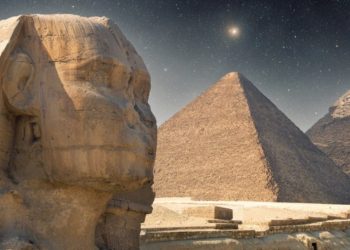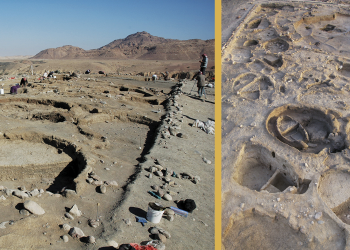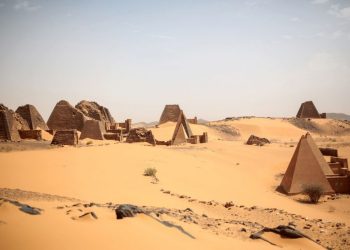One of the most astounding ancient monuments on the planet’s surface is the Great Sphinx of Giza, a statue unlike any other. Mainstream Egyptologists ‘estimate’ that the Sphinx was sculpted around the XXVI century BC., forming part of the king’s funeral complex during the IV dynasty of Egypt. In other words, the Sphinx was most likely carved when the Great Pyramid of Giza was being built.
Just like the statue, its name is another one of the many mysteries hidden at the Giza plateau. Since there isn’t a single record, or for that matter, any inscription from the Old Kingdom mentioning the sphinx, it is impossible to know when it was carved, who carved it, and what its purpose was. In the New Kingdom, the Sphinx was revered as the solar deity Hor-em-akhet and the pharaoh Thutmose IV (1401–1391 or 1397–1388 BC) specifically referred to it as such in his “Dream Stele.”
Missing links
But that’s about everything we have on the Sphinx; it was already ancient to the ancient Egyptians. In fact, the name we used today to describe it, the Sphinx, was given to the statue some 2,000 after it was created. Its modern Egyptian name is Abū al Hūl, which translates in English to “The Terrifying One.” Egyptologists usually claim that the Great Sphinx represents the pharaoh Khafre.

An ongoing mystery
However, Selim Hassan an Egyptologist who penned down a 16-volume Encyclopedia of Ancient Egypt in Arabic, explained in 1949:
Taking all things into consideration, it seems that we must give the credit of erecting this, the world’s most wonderful statue, to Khafre, but always with this reservation: that there is not one single contemporary inscription which connects the Sphinx with Khafre; so, sound as it may appear, we must treat the evidence as circumstantial, until such time as a lucky turn of the spade of the excavator will reveal to the world a definite reference to the erection of the Sphinx.
Generally speaking, the exact date and construction of the Sphinx and its true purpose are not universally accepted, and numerous theories and hypotheses have tried to explain the builder and the dating. Several studies have been made in the not-so-distant past to understand the Sphinx, who it was built for, when, and why. For me, the Great Sphinx is the Guardian of the Pyramids and protector of the underworld.
Sealed-off Shafts and entrances
It is no mystery that there are passageways that are believed to lead inside the Sphinx. Their existence is well documented, and we know where they are located. But strangely, some were sealed off in the distant past, adding more fuel to the mystery of what lies beneath and inside the Great Sphinx. A shaft at the back of the monument was first identified by Johan Michael Vansleben in 1679 and explored by Egyptologist Auguste Mariette in 1853. This entrance is thought to have been sealed off in 1926 during restoration work.
Fissures, cavities, and more
When Auguste Mariette explored the sphinx, he identified the opening as a natural fissure, although evidence suggests it is more than just that. In fact, this tunnel is thought to run through the entire body of the Sphinx and leads towards a chamber just beneath it. This void, however, may be nothing more than a natural fissure, channel, or chamber found beneath the Giza plateau’s limestone.
But curiously, there is evidence that these cavities and chambers were explored in ancient times and expanded. If this is true, why would the ancients expand existing tunnels? What was their use? More evidence of sealed-off entrances can be found on the top of the head of the Sphinx.

It was precisely there where some authors have argued exists an entrance leading towards a smaller inner chamber.
In the book Message of the Sphinx, Graham Hancock, and Robert Bauval have argued that the Egyptian authorities, together with American archaeologists, have blocked any studies around or beneath the Sphinx, which prevents anyone from researching the underground cavities and revealing the possible secrets that the Sphinx guards.
There are nearby entrances that lead into a world beneath the surface
And one such entrance is the Mysterious Osiris Shaft, located beneath the surface, not far from the Great Pyramid of Giza. The underground structure is one that was intricately carved and divided into three distinct levels. Although its existence has been known for a long time, the shaft and its contents were not properly explored until recently. One of the few people who explored the subterranean structure in the not-so-distant past was Egyptologist Selim Hassan who explored it in the 1930s.
Descriptions of the shaft
Hassan described the shaft in 1933-1934:
“Upon the surface of the causeway, they first built a platform in the shape of a mastaba, using stones taken from the ruins of the covered corridor of the causeway. In the center of this superstructure, they sank a shaft, which passed through the roof and floor of the subway running under the causeway to a depth of about 9.00 m. At the bottom of this shaft is a rectangular chamber, in the floor of the eastern side of which is another shaft. This descends about 14.00 m. and terminates in a spacious hall surrounded by seven burial-chambers, in each of which is a sarcophagus. Two of these sarcophagi, which are of basalt and are monolithic, are so enormous that at first, we wondered if they contained the bodies of sacred bulls.”
Now if there are entrances leading beneath the Giza plateau in the vicinity of the pyramid, why wouldn’t there be entrances that lead to chambers and tunnels beneath the Sphinx? The pyramids were also built featuring intricate, secret, and hidden chambers in their interior, some of which we only discover now. And if the pyramids have chambers and rooms, why wouldn’t the Sphinx have them as well?
Evidence of a subterranean world beneath and inside the Sphinx
There is evidence of chambers, tunnels, and cavities, not only beneath the sphinx but inside it. Charles Thompson, who explored the Sphinx in 1733, spoke of entrances and a “hole in the top of the back” of the Sphinx. But when looking for more modern explorations of the Sphinx and what located inside and beneath it, we have to turn to a study from 1987, performed by a Japanese team from Waseda University (Tokyo), led by Sakuji Yoshimura.
Electromagnetic surveys
In 1987, the scientists successfully carried out an electromagnetic survey of the Khufu Pyramid and the Great Sphinx and found a number of anomalies that they eventually went on to report. They discovered entrances just south of the Sphinx as well as hollow parts in the ground where they identified several cavities ranging from two to three meters in diameter. They discovered a groove extending beneath the body of the Sphinx. North of the Sphinx, they found similar grooves indicating the possibility of the existence of tunnels that lead directly beneath the monuments. The also came across hollow cavities located in front of the Sphinx’s paws.
The WASEDA Report Highlights
The following excerpts are from Studies in Egyptian Culture No. 6: Non-Destructive Pyramid Investigation (1) By Electromagnetic Wave Method by Sakuji Yoshimura, Takeshi Nakagawa, Shioji Tonouchi, and Kazuaki Seki (Tokyo: Waseda University, 1987; grammatical errors remain uncorrected):
- Area south of the Sphinx
Seven measuring lines were installed east and west and four measuring lines north and south to scan the Sphinx over 70 meters from the east to the west and over 10 meters from the north to the south. The bedrock of the Sphinx contains more moistures than that of the pyramid. This would be because the Sphinx locates closer to an underground stream. A response was obtained which would indicate that there is a plash 2.5 to 3 meters below the ground surface near the south-eastern forefoot. On its body, a groove with a width of 2 meters, a depth of 3 meters, and a length of 2 meters was found which seems to extend underneath the body. At the center of the southern rock, vertical cracks were observed; however, the cracks never seem to affect the bedrock.
- Area north of the Sphinx
Four measuring lines were installed east and west and five measuring lines north and south to scan the Sphinx over 60 meters from the east to the west and over 7 meters from the north to the south. The northern bedrock seems to contain more moistures than the southern bedrock. The vertical cracks, run east and west across the Sphinx, would be produced naturally. On the body, there is a groove similar to that on the southern part, which seems to extend underneath the body. Under the Sphinx, therefore, there may be a tunnel. Further, near the front elbow, a geometrical cavity (1m x 1.5m x 7m) has been detected, possibly containing metal or granite. (Source)
Read more about the report here.
Have something to add? Visit Curiosmos on Facebook. Join the discussion in our mobile Telegram group. Also, follow us on Google News.











